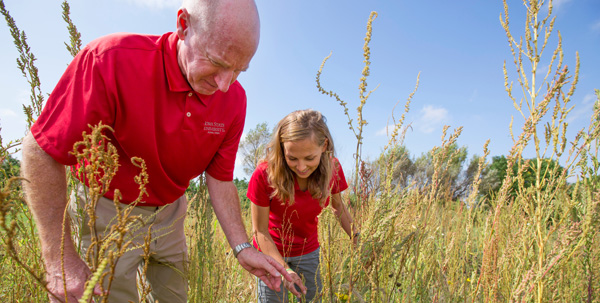
Teaming Up to Battle Palmer Amaranth
Waterhemp is one of the worst weeds Iowa farmers face. It produces a large number of seed and germinates late in the summer so it is not controlled by early season herbicide applications.It has incredible genetic diversity, which allows for increased herbicide resistance.
Multiply its growing power and resistance, and the result is its genetic cousin—Palmer amaranth.
Palmer amaranth is a pigweed species not native to Iowa. Since moving into the state from the south in 2013, it has been found in 50 counties. With no easy treatment options, Iowa State University is working with farmers, industry specialists and state agencies to slow its spread.
“Be constantly alert,” says Bob Hartzler, agronomy professor and weed specialist with Iowa State University Extension and Outreach. “The majority of Iowa’s fields have waterhemp, so it’s so easy to get complacent when encountering pigweeds.”
Hartzler (’78 agronomy, ’87 PhD) teamed up with the Iowa State University Extension and Outreach crops team including Meaghan Anderson, extension field agronomist. Together they raise awareness of the dangers of the weed and the importance of vigilance and management.
“We want farmers to be able to identify Palmer amaranth in fields and understand how important it is to manage it quickly and properly,” says Anderson (’12 agronomy, ’14 MS crop production and physiology).
They work with industry and government partners to offer statewide meetings, media campaigns and extension publications to help curtail its spread.
“Working with Iowa State University Extension and Outreach is important because they are an unbiased party giving farmers direction,” says Dean Grossnickle (’95 agricultural business), field agronomist with Syngenta. “They’ve done a very good job of raising awareness. They aren’t crying wolf—it’s a very bad weed. By being proactive we still have a chance to manage it.”
While widespread crop losses have not been reported in Iowa fields, an increased need for herbicides is cutting into profit margins. The cost of herbicides for soybean has more than doubled in the last three years, almost entirely because of herbicide-resistant waterhemp. If Palmer amaranth is allowed to spread, those costs will continue to rise.
Anderson recommends farmers plant and harvest fields containing Palmer amaranth last in order to avoid spreading its seed. Soybean fields are key to scout late in the season, as Palmer amaranth will be easier to find above this crop than in corn.
“The Palmer amaranth we are seeing now is not reaching its full potential,” Hartzler says. “Weeds need a period of time to adapt to new environments. There is no doubt Palmer amaranth will adapt to live in Iowa, so now is the time to go after it. We have the chance to eradicate it from most fields where it has been found, and greatly reduce the rate it spreads in the state. It would be a huge mistake to miss this opportunity.”



